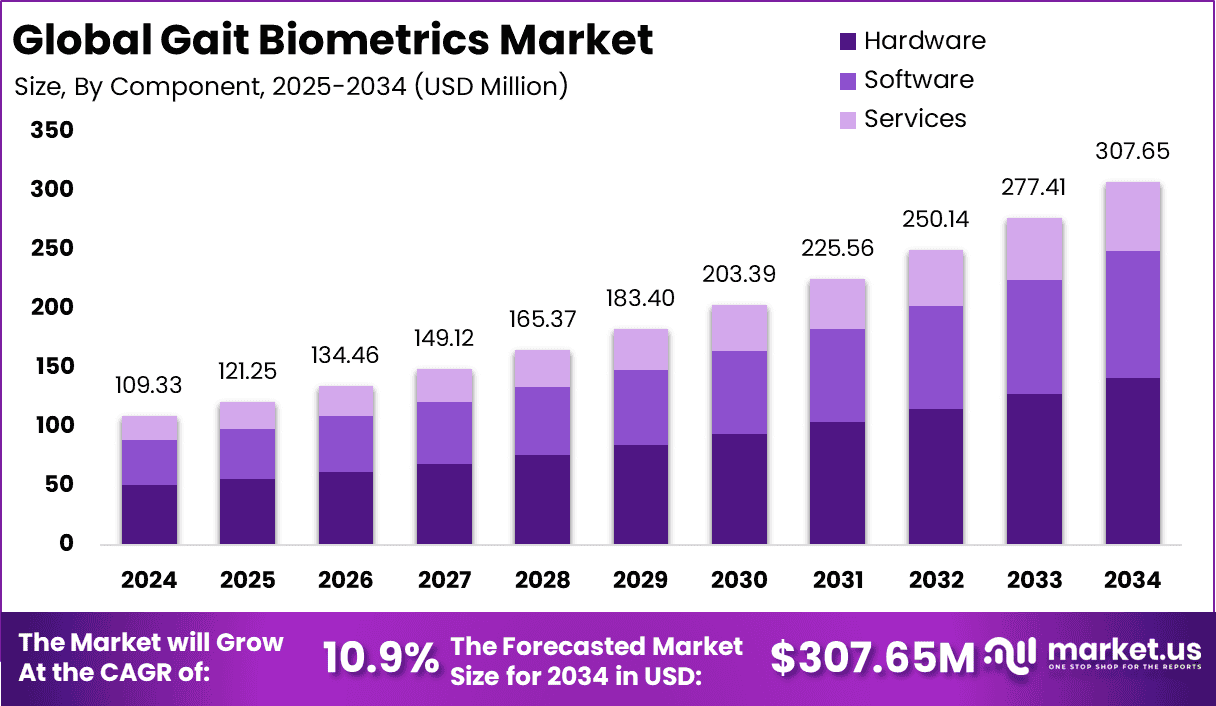Table of Contents
Introduction
The Global Gait Biometrics Market is projected to grow from USD 109.33 million in 2024 to approximately USD 307.65 million by 2034, registering a CAGR of 10.9% during 2025-2034. Gait biometrics, which analyze individuals’ walking patterns for identification and authentication, are gaining traction in security, healthcare, and surveillance sectors. In 2024, North America led the market with a 35.7% share, generating USD 39 million in revenue. Increasing demand for non-invasive biometric technologies and advancements in AI and sensor technology are key drivers of this market’s growth.

How Growth is Impacting the Economy
The growth of the gait biometrics market contributes positively to the economy by fostering advancements in security, healthcare, and law enforcement industries. Gait recognition technology enables more secure and contactless identification systems, reducing fraud and enhancing public safety. In healthcare, gait analysis supports rehabilitation and early diagnosis of neurological disorders, improving patient outcomes and reducing healthcare costs. The market expansion promotes investments in AI, sensor development, and data analytics, creating high-skilled jobs and technological innovation. Additionally, gait biometrics facilitate smart city implementations, enhancing urban security and operational efficiency, which collectively boost economic development.
➤ Discover how our research uncovers business opportunities @ https://market.us/report/global-gait-biometrics-market/free-sample/
(Use corporate mail ID for quicker response)
Impact on Global Businesses
Businesses face increasing costs associated with developing advanced gait recognition algorithms, sensor hardware, and integration into existing systems. Supply chain disruptions may affect component availability, requiring adaptive procurement strategies. The security, healthcare, and surveillance sectors leverage gait biometrics to improve identification accuracy, reduce identity theft, and enhance patient monitoring. Companies adopting gait biometrics gain competitive advantages through innovative, non-invasive solutions. However, challenges related to privacy regulations and data security necessitate robust compliance frameworks. Organizations delaying adoption risk lagging behind competitors that capitalize on improved biometric capabilities.
Strategies for Businesses
Businesses should focus on continuous R&D to enhance algorithm accuracy and sensor performance. Collaborating with AI and sensor technology providers accelerates innovation and market entry. Investing in data privacy and cybersecurity frameworks ensures regulatory compliance and customer trust. Developing scalable, interoperable systems facilitates integration across various applications. Workforce training in biometric technologies and AI analytics is essential. Companies can expand market reach by tailoring solutions to diverse sectors such as healthcare, security, and smart infrastructure. Maintaining agility in adapting to evolving regulatory landscapes and technology trends is critical.
Key Takeaways
- Gait biometrics market growing steadily driven by security and healthcare demand
- Non-invasive technology enhances identification and patient monitoring
- Rising costs and supply chain challenges require strategic management
- Privacy, cybersecurity, and regulatory compliance are vital
- Cross-sector application expands market potential
➤ Get full PDF access here @ https://market.us/purchase-report/?report_id=149137
Analyst Viewpoint
The gait biometrics market is set for sustained growth as demand for secure, non-contact identification increases globally. Advances in AI and sensor technologies will improve accuracy and application scope. The market outlook remains positive, supported by rising security concerns and healthcare innovations. Companies investing in R&D, partnerships, and compliance will lead the competitive landscape. Continued innovation and regulatory alignment will drive widespread adoption and market expansion.
Regional Analysis
North America leads the gait biometrics market with a strong presence of technology innovators, high security awareness, and government support. Europe shows steady growth driven by privacy-focused biometric applications and healthcare adoption. Asia-Pacific is emerging rapidly due to increasing security infrastructure investments and smart city initiatives in China, Japan, and India. Latin America and the Middle East & Africa are nascent markets with growing interest in biometric security solutions and healthcare modernization.
➤ Discover More Trending Research
- Cross-border Payments Market
- Soil Testing Robot Market
- Digital Twins in Artificial Lift Operations Market
- Last Mile in E-Commerce Delivery Market
Business Opportunities
Opportunities abound in developing advanced gait recognition algorithms, wearable sensors, and AI analytics platforms. Providers can cater to sectors including law enforcement, healthcare rehabilitation, access control, and smart city surveillance. Integration with multi-modal biometric systems offers enhanced security solutions. Emerging markets offer growth potential via infrastructure upgrades and digital identity initiatives. Customizable and privacy-compliant solutions present niche opportunities. Collaborations between AI developers, sensor manufacturers, and system integrators accelerate market innovation.
Key Segmentation
- By Technology: Vision-based, Sensor-based
- By Application: Security & Surveillance, Healthcare & Rehabilitation, Access Control, Forensics
- By End-User: Government, Healthcare Providers, Enterprises, Law Enforcement
- By Region: North America, Europe, Asia-Pacific, Latin America, Middle East & Africa
Key Player Analysis
Leading companies invest heavily in AI-driven gait analysis software, advanced sensor technologies, and integration capabilities. Strategic partnerships with government agencies, healthcare institutions, and security firms accelerate deployment. R&D focuses on improving recognition accuracy under varying conditions and enhancing privacy safeguards. Compliance with data protection regulations and international standards is prioritized. These companies provide scalable, adaptable solutions that meet diverse application needs, ensuring competitive advantage and strong market positioning.
Recent Developments
In early 2025, major players launched enhanced gait biometric platforms featuring real-time analysis and improved accuracy in challenging environments. Partnerships between AI firms and security agencies expanded adoption. Increased funding supported wearable sensor innovation and healthcare applications.
Conclusion
The gait biometrics market is poised for steady expansion driven by rising demand for secure, non-invasive identification and healthcare monitoring. Strategic investments in technology, privacy, and partnerships will enable businesses to capitalize on emerging opportunities. As adoption grows globally, gait biometrics will play a vital role in enhancing security and healthcare outcomes.
Discuss your needs with our analyst
Please share your requirements with more details so our analyst can check if they can solve your problem(s)



